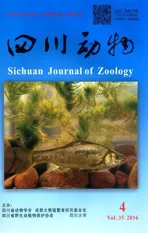缺齿鼩鼱属Chodsigoa的分类学研究概况
2016-04-01刘莹洵靳伟刘少英宗浩
刘莹洵, 靳伟, 刘少英*, 宗浩*
(1. 四川师范大学,成都610101; 2. 四川省林业科学研究院,成都610081)
缺齿鼩鼱属Chodsigoa的分类学研究概况
刘莹洵1, 靳伟2, 刘少英2*, 宗浩1*
(1. 四川师范大学,成都610101; 2. 四川省林业科学研究院,成都610081)
缺齿鼩鼱属Chodsigoa由Kastschenko于1907年作为长尾鼩鼱属Soriculus的一个亚属而建立。Thomas于1908年将其提升为属。该属种类主要分布于中国。其属级分类单元争议很大,一些学者认为是独立属,一些学者认为是长尾鼩鼱属的亚属。属下分类方面,不同学者的分类意见也有所不同。其中,Hutterer(2005)将其作为独立属并包括8个种的观点逐步得到大多数人的认可。造成意见分歧的主要原因是以往的系统学研究主要是以形态学研究为主,分子系统学研究较少。
缺齿鼩鼱属;分类;系统学
缺齿鼩鼱属Chodsigoa由Kastschenko于1907年作为长尾鼩鼱属Soriculus的一个亚属而建立(Kastschenko, 1907)。Thomas于1908年将其提升为属(Thomas, 1908)。在最新的分类系统中,Chodsigoa属级分类地位得到承认,同时被认可的还有8个物种的种级分类地位,其中7个种分布在中国。这一分类学观点得到大多数人的承认,但仍有不同意见。现对缺齿鼩鼱属的分类学研究概况介绍如下。
1 缺齿鼩鼱属分类特征
缺齿鼩鼱属Chodsigoa由Kastschenko于1907年建立,为长尾鼩鼱属的亚属,模式种为Soriculushypsibiusde Winton,1899。Thomas(1908)将其提升为属,形态上接近长尾鼩鼱属,但在齿列上呈现出明显的差异。鼩鼱属Sorex和川鼩属Blarinella上颌有5枚单尖齿,长尾亚洲鼩属Episoriculus上颌有4枚单尖齿,缺齿鼩鼱属上颌仅有3枚单尖齿,其齿式为3.1.1.3/1.1.1.3=28,且P4-M2的后缘有深凹口,脑颅较扁(除云南缺齿鼩C.parca颅骨拱起)。
2 缺齿鼩鼱属的分类地位
长尾鼩鼱属缺齿鼩鼱亚属成立后,Thomas(1908)、Allen(1923)、Osgood(1932)和Allen(1938)将其作为属级分类单元。但Ellerman和Morrison-Scott(1951)仍将其作为长尾鼩鼱属的亚属。Corbet(1978)、Hoffmann(1985)、Corbet和Hill(1992)、Hutterer(1993)等同意Ellerman和Morrison-Scott(1951)的意见。Repenning(1967)再次将其作为属级分类单元,Jameson和Jones(1977)、Hutterer(1993,2005)、Motokawa等(1997,1998)等同意Repenning(1967)的意见。而Ohdachi等(2006)通过分子系统学的研究发现Chodsigoa,Soriculus,Episoriculus这3个属可能是并系关系。
3 缺齿鼩鼱属种级分类及其争议
Allen(1938)认为缺齿鼩鼱属包含4个种:大长尾鼩C.salenskii、缺齿鼩C.smithii(包括2个亚种:C.s.smithii、C.s.parca)、川西长尾鼩C.hypsibia(包括3个亚种:C.h.hypsibia、C.h.larvarum、C.h.lamula)和滇北长尾鼩C.parva。Ellerman和Morrison-Scott(1951)认为Chodsigoa是Soriculus的一个亚属,该亚属包括3个种(8个亚种),分别为川西长尾鼩S. (C.)hypsibius[包括4个亚种:S. (C.)h.hypsibius、S. (C.)h.larvarum、S. (C.)h.lamula、S. (C.)h.parva]、大长尾鼩S. (C.)salenskii[包括4个亚种:S. (C.)s.salenskii、S. (C.)s.smithii、S. (C.)s.parca、S. (C.)s.furva和S. (C.)lowei]。另外还有1个种分类地位未定,也列入该亚属:阿里山长尾鼩C.sodalis。Honacki等(1982)也认为Chodsigoa是Soriculus的一个亚属,包括4个种,除Ellerman和Morrison-Scott(1951)提到的3个种外,还提升缺齿鼩S. (C.)smithii作为独立种,没有提及亚种。Hoffmann(1985)认为缺齿鼩鼱属是长尾鼩鼱属的亚属,在该亚属下,Hoffmann(1985)认为有5个种:川西长尾鼩S. (C.)hypsibius、甘肃长尾鼩S. (C.)lamula、大长尾鼩S. (C.)salenskii、缺齿鼩S. (C.)smithii和云南缺齿鼩S. (C.)parca,并认为larvarum是hypsibius的同物异名;lowei和furva是S. (C.)parca的亚种;parva是S. (C.)lamula的亚种。Hutterer(1993)也认同Chodsigoa是Soriculus的一个亚属,包括5个种:川西长尾鼩S. (C.)hypsibius、大长尾鼩S. (C.)salenskii、缺齿鼩S. (C.)smithii、甘肃长尾鼩S. (C.)lamula、云南缺齿鼩S. (C.)parca。王应祥(2003)认为Chodsigoa是一个单独的属,其包括6个种,除Hutterer(1993)的5个种外,还包括阿里山长尾鼩C.sodalis。Hutterer(2005)认为Chodsigoa是一个单独的属,包含8个种,除王应祥(2003)提到的6个种外,还包括滇北长尾鼩C.parva及2003年在越南北部发现的新种——高氏缺齿鼩C.caovansunga。蒋志刚(2015)同意Hutterer(2005)的意见。
综上所述,缺齿鼩鼱属的所有成员中,除川西长尾鼩C.hypsibia基本没有争议,另外高氏缺齿鼩C.caovansunga才建立不久,研究很少外,其余所有物种在种的分类上均存在一定的争论。
3.1Chodsigoalarvarum的分类地位
1907年,Anderson在河北北平地区采集到样本,Thomas(1912)将其命名为C.larvarum。Allen(1938)认为C.larvarum是川西长尾鼩C.hypsibia的一个亚种。Ellerman和Morrison-Scott(1951)、王应祥(2003)同意Allen(1938)的意见,将C.larvarum作为C.hypsibia的一个亚种。Hoffmann(1985)、Hutterer(1993,2005)认为C.larvarum是C.hypsibia的同物异名。
3.2Chodsigoasmithii的分类地位
1910年,Anderson和Smith在四川康定地区采集到样品,1911年Thomas将其命名为C.smithii。Allen(1938)将其作为缺齿鼩鼱属一个单独的种,其包含C.smithii和C.parka2个亚种。Ellerman和Morrison-Scott(1951)则认为C.smithii为C.salenskii的一个亚种。但Hoffmann(1985)指出,C.smithii相对于C.salenskii分布更为广泛,且头体长大于C.hypsibius,同时认为其可能具有一定的树栖习性,所以作为一个独立种。Corbet(1978)、Honacki(1982)、Hutterer(1993)、Smith(2009)亦将其作为一个单独的种。
3.3Chodsigoalamula的分类地位
1912年,Thomas(1912)根据采自甘肃临潭的1号标本描述为C.lamula,并将其描述为一个单独的种,但指出其与C.hypsibia非常相近。Allen(1938)将其作为C.hypsibia的一个亚种,其正常的毛色和比例均和C.hypsibia一致,但体型小于C.hypsibia,头骨大小略小于C.hypsibia,且眶间区域更低更平坦。Ellerman和Morrison-Scott(1951)以及Corbet(1978)也同意Allen(1938)的意见。但Hoffmann(1985)指出C.lamula和C.hypsibia曾同时出现在四川汶川草坡地区,具有同域分布的特点,但大小有明显区别,同时依据Allen(1923)对2个种描述对比的形态差异,认为其是独立种。 Hutterer(1993,2005)同意Hoffmann(1985)的意见。王应祥(2003)、Smith(2009)、蒋志刚(2015)也认同该观点。
3.4Chodsigoaparca的分类地位
Allen(1923)根据在云南西部采集的标本,将C.parca描述为C.smithii的一个亚种。Allen(1938)仍然坚持这一观点。Ellerman和Morrison-Scott(1951)、Honacki(1982)也认同此观点。但Hoffmann(1985)却认为应当将C.parca提升为一个种,其原因在于C.parca尺寸更小,且其吻部更窄,并在前颌骨处逐渐变细,并暂时包含了lowei和furva作为亚种。Hutterer(1993,2005)、Smith(2009)同意Hoffmann(1985)的意见。
3.5Chodsigoaparva的分类地位
Allen(1923)在云南发现的样品最初命名为C.hypsibiaparva。Allen(1938)将其提升为种。Ellerma和Morrison-Scott(1951)、Corbet(1978)、Honacki(1982)继续将其作为是C.hypsibia的一个亚种。Hoffmann(1985)把它作为C.lamula的同物异名。Hutterer(1993)把C.parva作为C.lamula的亚种。Hutterer(2005)再次将C.parva提升为Chodsigoa的独立种。
3.6Chodsigoasalenskii的分类地位
C.salenskii于1907年由Kastschenko作为Chodsigoa亚属成员而命名。Allen(1923)也认同其种级分类地位,同时指出其形态特征明显与缺齿鼩鼱属的其他种有区别。Hoffmann(1985)检查了这个种的正模标本,认为其是斯氏缺齿鼩C.smithii的同物异名,但同时指出缺齿鼩C.smithii相对于C.salenskii有更为广泛的分布。Ellerman和Morrison-Scott(1951)、Honacki(1982)和Hutterer(2005)均认为其是缺齿鼩鼱属中一个独立的种。
4 缺齿鼩鼱属的分布
缺齿鼩鼱属共有8种,其中有7种分布在中国(Hutterer,2005;蒋志刚,2015),包括C.hypsibia、C.lamula,C.parca、C.parva、C.salenskii、C.smithii和C.sodalis。缺齿鼩鼱属种类主要分布于中国西南地区,在越南北部,缅甸北部及泰国亦有分布,除川西长尾鼩C.hypsibia河北种群分布点高度在海拔300 m以外,通常分布于较高海拔的地区(Lundeetal.,2003;Smith,2009),只有C.sodalis仅分布于中国台湾,为中国台湾特有种;而Lunde等(2003)在越南河江省Mt. Tay Con Linh Ⅱ山发现新种C.caovansunga,在中国云南省个旧市蔓耗镇也有记录(何锴等,2012),并推断该物种还可能分布于越南北部以及中国西南山地森林中。
5 讨论
缺齿鼩鼱属主要分布于中国,其很多种级分类地位存在一定的争论。该属究竟包括多少种?到目前为止还没有取得一致意见。究其原因,是因为以往的研究,包括Allen(1938)、Ellerman和Morrison-Scott(1951)、Honacki(1982)、Hoffmann(1985)、Hutterer(1993,2005)、Motokawa(1997)等均是基于形态学研究的结果,且因标本较少而无法进行系统的研究。Ohdachi等(2006)通过对Cytb的分子系统学研究指出Chodsigoa、Soriculus、Episoriculus这3个属是独立的且可能存在并系关系,并指出阿里山长尾鼩C.sodalis是独立于台湾长尾鼩E.fumidus的一个种;Dubey等(2007)对C.caovansunga、C.sodalis、C.parca通过Cytb、16S核糖体基因、BRCA1基因和APOB基因开展了分子系统学研究,同时指出缺齿鼩鼱属位于蹼足鼩族中,且与E.fumidus在APOB基因树中构成姐妹群关系;He等(2010)通过对3个核基因(APOB、BRCA1、RAG2)和8个线粒体基因(12S rRNA、16S rRNA、Cytb、ND2、COⅠ、ND4、ND5、ATP6)进行的贝叶斯树分析,对C.sodalis、C.parca、C.hypsibia进行了分子系统学研究,认为Chodsigoa、Soriculus、Episoriculus这3个属是并系的且可分为4个世系。这些研究虽通过分子系统学对缺齿鼩鼱属和属内部分种类进行了一定的研究,但也未能明确确定属内各种的分类地位。由此看来,缺齿鼩鼱属的分类学问题需通过分子系统学结合形态学研究才能得到更好的解决。
何锴, 邓可, 蒋学龙. 2012. 中国兽类鼩鼱科一新纪录——高氏缺齿鼩[J]. 动物学研究, 33(5): 542-544.
蒋志刚. 2015. 中国哺乳动物多样性研究与保护[J]. 世界环境, (A01): 22-25.
Smith AT, 解炎, 汪松. 2009. 中国兽类野外手册[M]. 长沙: 湖南教育出版社.
王应祥. 2003. 中国哺乳动物种和亚种分类名录与分布大全[M]. 北京: 中国林业出版社.
Allen GM. 1923. New Chinese insectivores[J]. American Museum Novitates, 100: 1-11.
Allen GM. 1938. The mammals of China and Mongolia, Part Ⅰ[M]. New York: American Museum of Natural History.
Corbert GB. 1978. The mammals of the Palaearctic region: a taxononmic review[M]. London: British Museum (Natural History).
Corbet GB, Hill JE. 1992. The mammals of the Indomalayan region: a systematic review[M]. New York: Oxford University Press.
Dubey S, Salamin N, Ohdachi SD,etal. 2007. Molecular phylogenetics of shrews (Mammalia: Soricidae) reveal timing of transcontinental colonizations[J]. Molecular Phylogenetics & Evolution, 44(1): 126-137.
Ellerman JR, Morrison-Scott TCS. 1951. Checklist of Palaearctic and Indian mammals 1758 to 1946[M]. London: Trustees of the British Museum (Natural History).
He K, Li YJ, Brandley MC,etal. 2010. A multi-locus phylogeny of Nectogalini shrews and influences of the paleoclimate on speciation and evolution[J]. Molecular Phylogenetics and Evolution, 56(2): 734-746.
Hoffmann RS. 1985. A review of the genusSoriculus(Mammalia: Insectivora)[J]. Journal of the Bombay Natural History Society, 82: 459-481.
Honacki JH, Kinman KE, Koeppl JW. 1982. Mammals species of the world[M]. Allen Press and Assoc: Syst. Coll. Lawrence, Kansas.
Hutterer R. 1993. Order Insectivora[M]// Wilson DE, Reeder DM. Mammal species of the world: a taxonomic and geographic reference. 2nd ed. Washington: Smithsonian Institution Press.
Hutterer R. 2005. Order Soricomorpha[M]// Wilson DE, Reeder DM. Mammal species of the world: a taxonomic and geographic reference. Baltimore: John Hopkins University Press: 220-311.
Jameson EW, Jones GS. 1977. The Soricidae of Taiwan[J]. Proceedings of the Biological Society of Washington, 90: 459-482.
Kastchenko NF. 1907.Chodsigoasubgen. nov. (Gen.Soriculus. fam. Sorieidae)[J]. Ezegod Zool Mus Akad Nack (Ann Mus Zool Aced Sci St Peterburg), 10: 251-254.
Lunde DP, Musser GG, Son NT. 2003. A survey of small mammals from Mt. Tay Con Linh Ⅱ, Vietnam, with the description of a new species ofChodsigoa(Insectivora: Soricidae)[J]. Mammal Study, 28(1): 31-46.
Motokawa M, Harada M, Lin LK,etal. 1998. Karyological differentiation between twoSoriculus(Insectivora: Soricidae) from Taiwan[J]. Mammalia, 62: 541-547.
Motokawa M, Yu HT, Fang YP,etal. 1997. Re-evaluation of the status ofChodsigoasodalisThomas, 1913 (Mammalia: Insectivora: Soricidae)[J]. Zoological Studies, 36: 42-47.
Ohdachi SD, Hasegawa M, Iwasa MA,etal. 2006. Molecular phylogenetics of soricid shrews (Mammalia) based on mitochondrial cytochrome b gene sequences: with special reference to the Soricinae[J]. Journal of Zoology, 270: 177-191.
Osgood WH. 1932. Mammals of the Kelley-Roosevelts and Delacour Asiatic expedition[J]. Field Museum of Natural History, Zoology Series, 18: 193-339.
Repenning GA. 1967. Subfamilies and genera of the Soricidae[J]. Geological Survey Professional Paper, 565: 1-74.
Thomas O. 1908. The Duke of Bedford’s zoological exploration in eastern Asia. X. List of mammals from the provinces of Chih-li and Shan-si, N. China[J]. Proceedings of the Zoological Society of London, 78(3): 635-646.
Thomas O. 1912. On a collection of small mammals from the Tsin-ling Mountains, central China, presented by Mr. G. Fenwick Owen to the National Museum[J]. Annals and Magazine of Natural History, 10(58): 395-403.
A Summary of Taxonomic Studies onChodsigoa
LIUYingxun1,JINWei2,LIUShaoying2*,ZONGHao1*
(1.Sichuan Normal University, Chengdu 610101, China; 2. Sichuan Academy of Forestry, Chengdu 610081, China)
Chodsigoawas initially established as a subgenus ofSoriculusby Kastschenko in 1907. Thomas (1908) elevatedChodsigoato a full genus based on craniodental morphology. Most recognized species and subspecies are endemic in China. The taxonomy and systematics ofChodsigoahave been changed in the last 100 years.Hutterer (2005) recognizedChodsigoaas a genus and included 8 full species, which has been widely accepted. Most systematics studies were based on morphological comparisons, and few species have been involved in molecular studies.
Chodsigoa; taxonomy; systematics
2016-03-18 接受日期:2016-05-31 基金项目:国家自然科学基金项目(31272274; 31470110)
刘莹洵(1990—), 男, 硕士研究生, 研究方向: 动物生态学, E-mail:491328944@qq.com
*通信作者Corresponding author, E-mail:493274915@qq.com; shaoyliu@163.com
10.11984/j.issn.1000-7083.20160059
Q959.8
A
1000-7083(2016)04-0638-03
